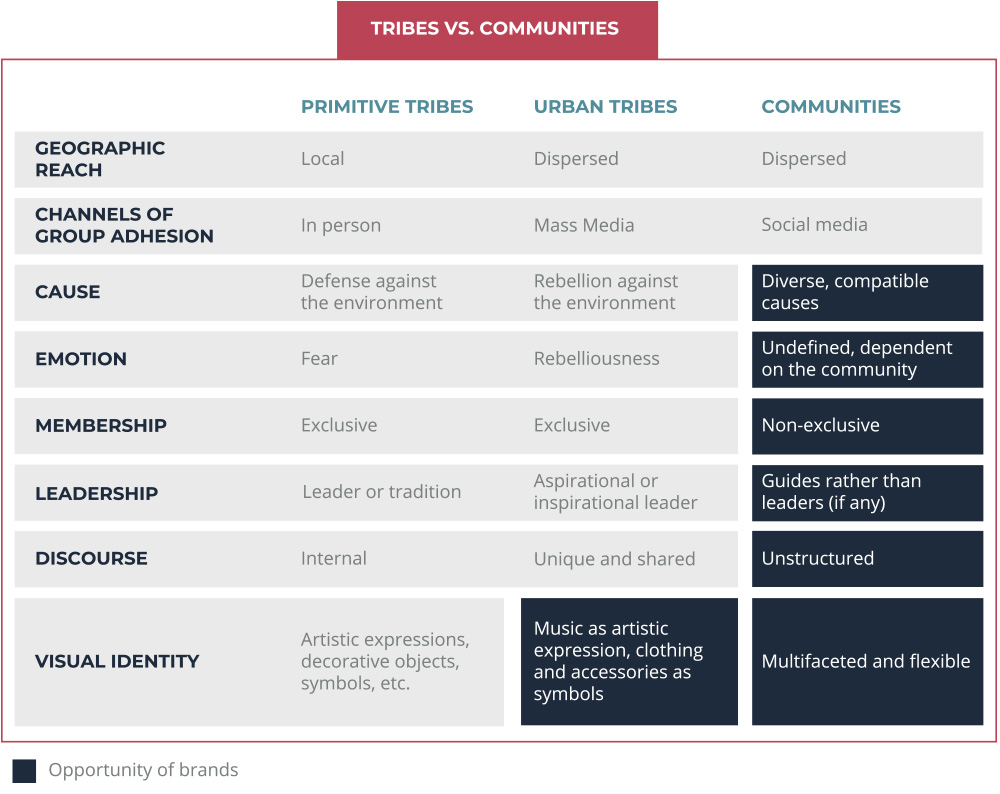The digital revolution has created a new multi-identity consumer profile that, when grouped into communities built around specific causes, shares a series of values and is located around the globe; But how do these communities build their identities?
Through social media, the new digital environment allows us to connect with individuals from any location, in any language and in any way, giving us the opportunity to group ourselves into communities that do not belong to a specific region and are not exclusionary. This encourages the creation of a flexible and multifaceted individual identity.
Brands seek to connect to these communities as a way to reach individuals with purchasing power. However, for this strategy to be effective, the group must have solid identifying characteristics in terms of the purpose, discourse and images its members share. Consistency is essential for these communities to exist in the long term, which is of vital importance for the brand’s initiative to be worth the effort.
Tribes and brands
To a certain extent, it can be said that urban tribes inherited many characteristics from primitive tribes: They emerged as a group’s response to its environment, they are exclusive from one another, they follow a leader and they place great importance on the external construction of their identity. However, they also build on characteristics of their own, which are especially relevant to brands:
- Belonging to an urban tribe is a voluntary choice, and, thanks to mass media, it is not limited to a specific region.
- These tribes appeared as a form of rebellion against the system, seeking to convey a specific message to the rest of society.
- The role of the leader is inspirational and aspirational. Group members are not required to follow their leader, but wish to do so and to emulate them.
- A group’s need to convey its purpose to society enhances the importance of its external identifiers, such as personal appearance.



There are great stories that showcase the role a brand can play in defining a group’s identity. The British film Quadrophenia, based on The Who’s rock opera and directed by Franc Roddam, is a good example of this. It tells the story of a violent confrontation between mods and rockers over a weekend in 1964 in the coastal town of Brighton. Jimmy’s Lambretta practically shares the spotlight with the lead actor, as the scooter became a symbol of the community.
Communities and brands
New online communities seem to hold greater appeal for brands, as they function as permeable groups whose members can join multiple communities and take part in every cause that interests them. However, consumers are aware of their power the digital revolution has given them and demand their relationships with brands provide them with a clear benefit.
Therefore, they accept being targeted by brands whose value proposition fulfils a least two of the following requirements:
- True and real.
- Non-exclusive.
- Beneficialfor its members.
Brands must adapt to each community to build a connection, using a more flexible message and more adaptable identity. This is an opportunity for any brand willing to engage in an exercise in humility by creating proposals based on listening to communities, then offering them tailor-made experiences in a continuous feedback loop.
The identifying features individuals relate to within each community are determined by how they consume and share content, leaving out those not to their tastes or any they find unrelatable. The ability to convey emotion is crucial, as emotions are the key to holding a group together. To paraphrase acclaimed speaker Simon Sinek, if you speak from the heart about your beliefs, you will attract like-minded people. The more dispersed the group is, the greater the value of sharing the same emotion.
Visual experience
We know that the human brain processes images up to 60,000 times faster text, and it has a greater capacity to retain visual content than any other form of information. On average, 40 percent of users react better to image-based content than plain text and publications with visual content are visited 94 percent more often. It could even be said that today’s communication needs to be visual.
A good example of the way strong audiovisual content can mobilize a dispersed community that rarely comes together can be found in the advertising campaign “Dad, why is the Atlético our team?” Launched by soccer team Atlético de Madrid launched in 2001, the campaign used emotion to maintain cohesion among its supporters. In the original ad, a child asks his father why they support the team, and his father is unable to answer. The content immediately struck a chord among the team’s supporters, who probably all shared memories of similar conversations they had with their fathers or their own children. The ad evoked the vibrant energy of the soccer field and the feeling of belonging to a community that takes pride in its values.
People’s natural knowledge of visual and graphic language is so vast that their adhesion to or rejection of our brand depends almost entirely on the quality of what we produce. As companies, we must introduce ourselves with the prevailing tools and languages our target communities use. More than ever, we must assume the medium is the message: our visual communication is the most powerful way to convey our brand identity.
From the moment our parents name us, we spend the rest of our lives trying to discover who the person in the mirror is. We consider how we wish to present ourselves to others, whether we are alone or in a group. Individuals welcome any help in this pursuit of identity. Those brands capable of embracing this have an unparalleled opportunity; the intersection between their identity and that of their target communities will provide an opportunity to convey their value to consumers and achieve the brand engagement so many companies seek.



